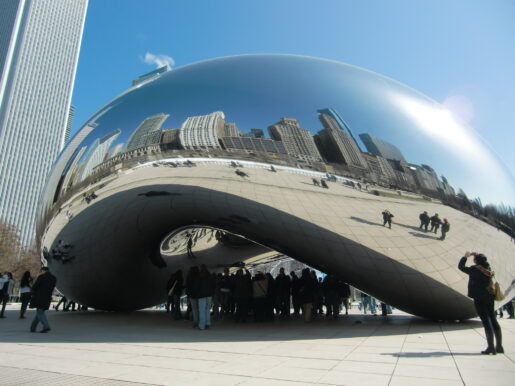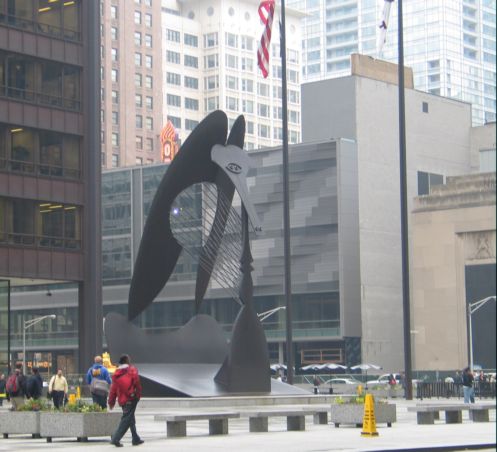“Picasso” (Photo by J Jacobs)
Hey, listen up travel friends and DNC Delegates and relatives who will be getting together in this, as Carl Sandburg says in his poem “Chicago”-a “City of the Big Shoulders.”
In 2024, it still has big shoulders even if no longer “Hog Butcher for the World” because Chicago is many other things. It’s a city of neighborhoods (about 170 of them within 70 designated community areas). It has world class museums and hotels, a delightful lakefront trail to run, top-notch shopping and restaurants. And the Downtown area is known for its Millenium Park and Architectural River Cruise.

But there is also another way to see and get to known Chicago’s downtown area. It’s to do a Public Art sculpture walk on your own- you can be guided by Choose Chicago, and/or an art deco walk with a Chicago Architecture Center tour because not all the city’s architectural features are visible by boat.
Sculpture
Start with “Cloud Gate” by Anish Kapoor, a commanding sight in Millenium Park that can be seen from Michigan Avenue south of Randolph Street near Washington Street. Fondly nicknamed “The Bean,” its unveiling took place July 2004 when it quickly became Chicago’s most popular tourist attraction. Snap your photo so you get a reflection of the skyline on the steel which is how Kapoor envisioned his sculpture.
(I wish you could just walk west on Randolph now to the James R. Thompson Center’s State of Illinois building at 100 W. Randolph St. to see Jean Dubuffet’s “Monument with Standing Beast.” It very impressively guarded the corner but was just removed this year. A popular Chicago sculpture, its fans are hoping it will be significantly placed in a public area soon.)
Instead, walk west of Michigan Avenue on Washington Street where Chicago’s once iconic sculpture, “The Picasso,” stands tall in Daley Plaza at 50 W. Washington St. It was gifted to Chicago by Pablo Picasso in 1967 and quickly came to represent the city with team decorations around its neck when a Chicago team or event was in the news.
After taking photos by The Picasso” turn around and look across the road for Joan Miró’s “Chicago” in the narrow Brunswick Building Plaza, 69 W. Washington St. Nicknamed “Miss Chicago,” this mixed-media sculpture reaching about 40 feet high, has been standing there since 1981.
Now walk south from the corner on Dearborn Street to see Marc Chagall’s glorious 1974 mosaic, “The Four Seasons.” Stretching 70 feet horizontally on Chase Tower Plaza at 10 S. Dearborn St., the artwork is made up of thousands of chips laid into 128 panels. Look for birds, flowers, fish and lovers. Chagall has often added or changed pieces as Chicago has changed. The overhead protection was added in 1994.
Continue South to 50 W. Adams St. where Alexander Calder’s 53-foot-tall, Flamingo stands out in the Federal Plaza. This is one of those “you can’t miss it” pieces with its bright red curves. Unveiled in 1974 it is a sharp contrast to the Mies van der Rohe buildings around it.
Now, it’s back east to Millenium and Grant Park on the east side of Michigan Avenue. If you read Millenium Park up above you know of the sculptures there, but there is another sculpture, sort of a sculpture series, south of the Art Institute of Chicago in Grant Park worth seeing.
It is the multi-legged, cast-iron “Agora” by Magdalena Abakanowicz. It consists of 9-foot-tall headless torsos that seem to be walking or standing still.
If you need a break, you pass good restaurants. Two within walking distance are the famed The Berghoff for German and deli food on Adams Street near Federal Plaza and The Gage on Michigan Avenue opposite Millenium Park for its upscale burgers and atmosphere.
Art Deco

Photo courtesy of CAC and One North LaSalle
Address Tip: Madison is 1 so all addresses north of Madison such as the 1 North LaSalle Street building is at the corner and is the first building north of Madison. All addresses saying south are south of Madison. State Street is the east-west divider so remember that when looking for a building with an east or west address.
Art Deco tip: Most of the Art Deco designed buildings have noticeable layered setbacks such as The Board of Trade.

(Photo courtesy of Chicago Architecture Center)
Certainly, Chicago is known for its architecture styles that lead and also mirror what is happening in the world. But among them is the important and somewhat lavish art deco style that is worth a separate walking tour. Chicago Architecture Center has a guide.
If connecting with the Chicago Architecture Center at Wacker Drive around the corner east of Michigan Avenue, you would start across Michigan Avenue at the Carbide and Carbon Building at 230 N. Michigan Ave. Now called the Pendry Hotel.
Built by the Burnham Brothers, it was completed in 1929 representing all that meant art deco, inside and out. Outside, note its black granite and 24 K gold top and gold leaf decorations. Inside see its decorative elevators.
Turn the corner to walk west on Wacker Drive to the Merchandise Mart, another of those can’t miss it buildings because it is sooo large. Indeed, it is considered by some to be the largest commercial building in the world and until2008 had its own zip code (60654). Go inside the doors on the south side of the building facing the water at 222 Merchandize Mart Plaza on the north side of the Chicago River to see the lobby and elevators. Designed by Alfred Shaw and built by Marshall Field and Company, it opened in 1930.
Next walk east to LaSalle Street and find the gold doors of One N. LaSalle. Go inside the lobby to snap photos of its gorgeous elevators. Built in 1930 by Vitzthum & Burns as one of the last Chicago art deco buildings by built in 1930, its lobby dazzles with gold.

Chicago Board of Trade
Continue south on LaSalle (Chicago’s financial district) to the tall building at its end. That is the famed Chicago Board of Trade, 141 West Jackson Boulevard designed by Holabird & Root At 605 feet (184 m) tall, it was the tallest in Chicago until them Richard J. Daley Center was built in 1965. Look up for its statue at the top of goddess Ceres. The building also has sculptures by Alvin Meyer.

